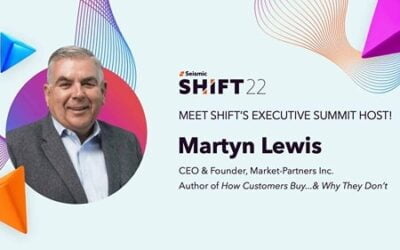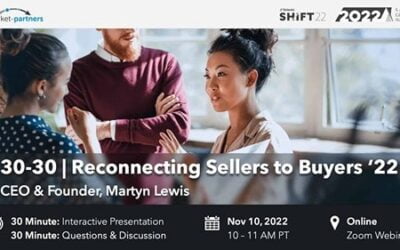Every year, the Customer Buying Journey becomes a hotter and hotter topic of discussion within the business world. And while we, as one of the earliest proponents of and educators on the buying journey, are thrilled to see it catch on in such a big way, we also can’t help but notice two worrying aspects surrounding these conversations.
First, much of the readily available information being written and shared on the buying journey only gives a surface level explanation of this incredibly deep, rich, and integral subject matter. Second, the amount of effort required to gain a truly comprehensive understanding of the buying journey is being woefully underestimated.
That is why we want to use our two-decades worth of buying journey research to create the best possible resource for mastering Customer Buying Journey. This article will serve as the first in a three-part series, giving in depth answers to some of the most frequently asked questions about this essential business concept.
1. What is the Customer Buying Journey?
2. How Do You Map the Customer Buying Journey?
3. How Do You Manage the Customer Buying Journey?
Without further ado, let’s get started with some buying journey fundamentals.
What Is the Customer Buying Journey?
The Customer Buying Journey is the spectrum of activities a buyer is likely to engage in when deciding whether to buy a particular offering, plus all the factors that could impact those activities and decisions. Counter intuitive to its name, it should be clarified that not all buying journeys end at a purchase, and some journeys do not end with purchase at all.
Though the specific steps and number of steps depend on the market and offering, all buying journeys share a basic macro anatomy: 1.) the journey starts from the first awareness of an opportunity or challenge, 2.) continues through the acquisition of the offering (including any additional products and services required to use it), and 3.) is “completed” with successful adoption and/or with an ongoing supplier-customer relationship.
Keep in mind that buying journeys can, and often do, stall or stop prematurely or end without resulting in the purchase of your offering. For example, a prospect could decide the acquisition is not worth the effort, may decide it’s better to revisit it at a later time, or buy an alternative from your competitor without even talking to you. None of these scenarios mean a buying journey did not occur.
What Isn’t a Buying Journey?
A buying journey is not the activities a supplier imagines their prospects would engage in or believes their prospects should engage in. Far too often, we see “buying journeys” mapped either using incomplete sales and marketing data on interactions or in accordance with a pre-existing sales process, pipeline, or cycle. Both of these cases come with their own distinct shortcomings.
In the first scenario, we have a business putting far too much emphasis on the few, limited pieces of the buying journey they can see. For example, their “buying journey” shows a prospect visiting the company website, sales giving them a call or two, and a month later, the prospect making a purchase. However, this “journey” does not account for everything the business can’t see; any investigating the customer did off the company website, how the customer found out about the offering, what prompted them to accept the calls, as well as every conversation, alternative, approval, budget, and competing agenda they delt with in that month leading up to the purchase. To put it all in perspective, our research shows that sellers are engaged in less than 10% of all buying activities.
The second situation puts too much faith in the organizations own offering. “Buying journeys” mapped to a business’ own internal sales process, pipeline, or cycle assumes there is nothing more valuable or important to the customer than the acquiring their product or service – but this is hardly ever the case. Buyers live and work in highly complex and dynamic worlds. They have many other things to do and think about. And when they do decide to instigate a buying journey, they have unprecedented information, choice, independence, and access to all markets.
What Are (and Aren’t) the Stages of a Buying Journey?
As stated above, there are no set “stages” of the Customer Buying Journey; they are entirely dependent on your market and offering. Although it may be tempting to think of journeys in terms of easy, catch-all pseudo-steps like “Awareness,” “Consideration,” “Decision,” this oversimplification is inherently dangerous. While these three things certainly happened – but what started the awareness? who was involved during consideration? how did they ultimately reach their decision? and were they satisfied with their choice after the fact?
Generic steps also don’t consider how vastly different, lengthy, and complicated journeys can be. Consider the difference between purchasing a car and purchasing car insurance. Your buying journey with your car likely ended whenever you finished its payment plan, but your buying journey with your car insurance is… hopefully… ongoing. Moreover, insurance goes beyond adding a fourth, band-aid step, like “Renewal.” Some customers will need to file a claim between their “Decision” and “Renewal,” but not every driver and not every year. And before you separate “Filing Claim” into its own journey, if you have ever filed a claim, you know this experience will greatly influence the chance you “Renew.”
These are the types of considerations that must be accounted for if an organization truly wants to understand and strategize around the buying journey. Generic steps leave far too many questions not only unanswered, but un-asked.
What Changes Across the Stages of the Buying Journey?
One of the most important dynamics of mapping a buying journey is understanding that things can change throughout it. For example, the buyer may gain new knowledge, and as a result, consider new alternatives, raise new concerns, or change their priorities. Another important factor would be to know how and when different key players get involved. What about procurement or technical resources?
As you are likely starting to realize, buying journeys are incredibly dynamic and intricate processes. But while these permutations and combinations may seem endless, this is all part of the Customer Buying Journey DNA. Once the six strands of a buying journey’s DNA have been decoded and mapped, you will see that a particular market buys in a remarkably similar way, and that the variables across any given buying journey can be anticipated and managed.
How has the Buying Journey Itself Changed?
The Customer Buying Journey has changed dramatically during the course of the new millennia. Up until the end of the 20th century, the salesperson held the keys. The buyer had to come to them to gain information, to understand the product, and learn how and if the offering matched what was required.
This has all changed. With the advent of the internet, the buyer now has all the information they need at their fingertips. Our studies have shown for the last 10 years that buyers don’t even contact salespeople until that are more than 50% through their buying process – more recently, 70% or further. This is easily understood when we consider that 74% of B2B buyers conduct more than half of their research online before making an offline purchase.
This clearly demonstrates revolution in the buying-selling equation, as the power has completely shifted from the seller to the buyer. The buyer is no longer at the mercy of the seller to get information; it is the buyer who now has the information that the seller needs. This is why the very notion of a sales process is outdated, and why mapping journeys to such a concept is fruitless. It is no longer the salesperson or sales process that sets the pace or dictates what happens next. It is the customer and their buying journey.
Can’t Wait for the Next Installment?
As a result of more than twenty years of research that included in-depth conversations with several thousand buyers, Martyn Lewis of Market-Partners Inc. have uncovered, defined, and documented exactly what goes on in the Customer Buying Journey.
In his book How Customers Buy …& Why They Don’t, Martyn Lewis makes the argument that anyone wanting to sell anything in today’s business world has to start by gaining a profound knowledge of their market’s buying journey, and he provides the ingredients and recipe for mapping and managing the very DNA of a specific market’s buying journey.




